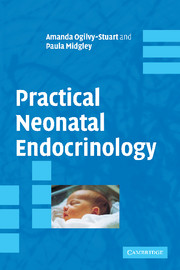Book contents
- Frontmatter
- Contents
- Acknowledgements
- Introduction
- 1 Hyperglycaemia
- 2 Hypoglycaemia
- 3 Management of hyperinsulinism
- 4 Hypoglycaemia in infant of a diabetic mother
- 5 Dysmorphic features
- 6 Micropenis
- 7 Hypopituitarism
- 8 Ambiguous genitalia (male): XY disorders of sex development
- 9 Cryptorchidism
- 10 Ambiguous genitalia (female): XX disorders of sex development
- 11 Pigmented scrotum
- 12 Adrenal failure
- 13 Collapse
- 14 Hypotension
- 15 Hyponatraemia
- 16 Hyperkalaemia
- 17 Hypernatraemia
- 18 Maternal steroid excess
- 19 Hypercalcaemia
- 20 Hypocalcaemia
- 21 Investigation and management of babies of mothers with thyroid disease
- 22 Maternal or familial thyroid disease
- 23 Goitre
- 24 Abnormal neonatal thyroid function tests
- 25 Hypothyroxinaemia in preterm infants
- Appendix 1 Calculation of glucose infusion rate
- Appendix 2 Dynamic tests
- Appendix 3 Normal ranges
- Appendix 4 Biochemistry samples
- Appendix 5 Formulary
- Index
7 - Hypopituitarism
Published online by Cambridge University Press: 15 February 2010
- Frontmatter
- Contents
- Acknowledgements
- Introduction
- 1 Hyperglycaemia
- 2 Hypoglycaemia
- 3 Management of hyperinsulinism
- 4 Hypoglycaemia in infant of a diabetic mother
- 5 Dysmorphic features
- 6 Micropenis
- 7 Hypopituitarism
- 8 Ambiguous genitalia (male): XY disorders of sex development
- 9 Cryptorchidism
- 10 Ambiguous genitalia (female): XX disorders of sex development
- 11 Pigmented scrotum
- 12 Adrenal failure
- 13 Collapse
- 14 Hypotension
- 15 Hyponatraemia
- 16 Hyperkalaemia
- 17 Hypernatraemia
- 18 Maternal steroid excess
- 19 Hypercalcaemia
- 20 Hypocalcaemia
- 21 Investigation and management of babies of mothers with thyroid disease
- 22 Maternal or familial thyroid disease
- 23 Goitre
- 24 Abnormal neonatal thyroid function tests
- 25 Hypothyroxinaemia in preterm infants
- Appendix 1 Calculation of glucose infusion rate
- Appendix 2 Dynamic tests
- Appendix 3 Normal ranges
- Appendix 4 Biochemistry samples
- Appendix 5 Formulary
- Index
Summary
Clinical presentation
Usually symptomatic hypoglycaemia which may result in convulsions.
Asymptomatic hypoglycaemia and prolonged jaundice.
Dysmorphic baby with midline anomalies.
Micropenis.
Congenital hypopituitarism is uncommon and may not present in the neonatal period.
It results from a deficiency of any or all of the hormones secreted by the pituitary gland:
Anterior pituitary hormones
– Adrenocorticotrophic hormone (ACTH).
– Thyroid-stimulating hormone (TSH).
– Luteinizing hormone (LH) and follicle stimulating hormone (FSH).
– Growth hormone (GH).
– Prolactin.
Posterior pituitary hormone
– Antidiuretic hormone (ADH).
There may be an isolated hormone deficiency (GH deficiency is the most common) or combined pituitary hormone deficiencies.
Approach to the problem
History: Perinatal complications (breech delivery, Caesarean section, prolonged or precipitous delivery, intrapartum distress, and a low APGAR score) are common.
Anterior hypopituitarism:
– Symptoms and signs of hypoglycaemia (see Chapter 2).
– Other symptoms and signs include micropenis (see Chapter 6), hypothermia, conjugated hyperbilirubinaemia.
– Dysmorphic features such as midline defects and craniofacial anomalies (see Chapter 5).
– Ophthalmic examination may reveal optic nerve hypoplasia/dysplasia.
– Most have a birth length and weight below the mean (although usually within normal centiles).
– Some have severe growth failure, even at birth.
– Although some children may grow normally in early childhood, in others growth failure is more immediate.
Posterior hypopituitarism:
– May present with polyhydramnios.
– After birth, there may be signs of dehydration: excessive weight loss, irritability, fever, hypernatraemia, convulsions, or coma.
– Breast-fed babies may present later with failure to thrive, anorexia, vomiting, fever, constipation, or developmental delay.
- Type
- Chapter
- Information
- Practical Neonatal Endocrinology , pp. 45 - 52Publisher: Cambridge University PressPrint publication year: 2006

